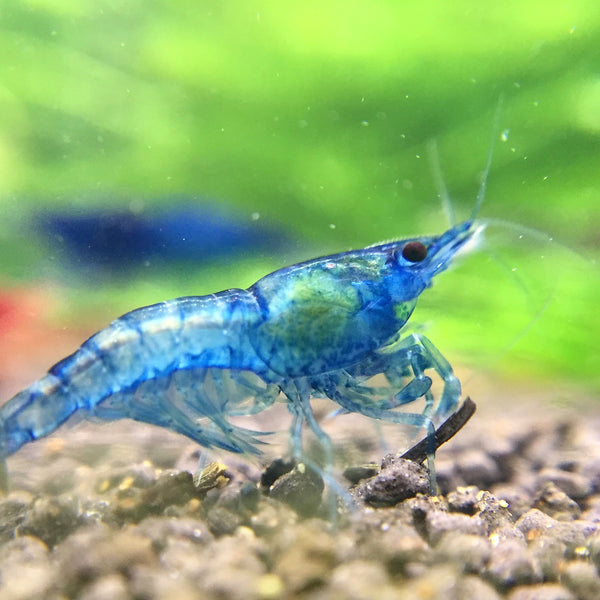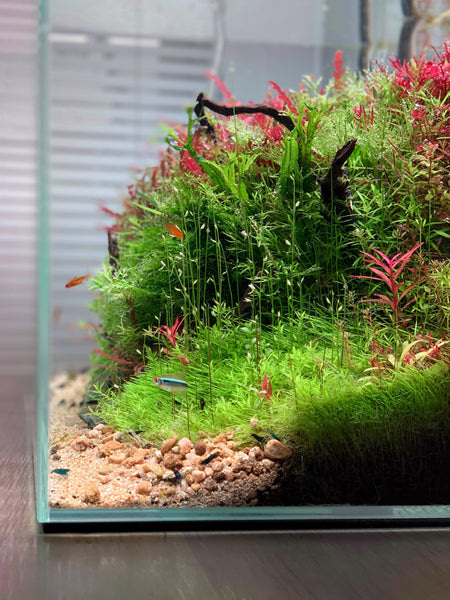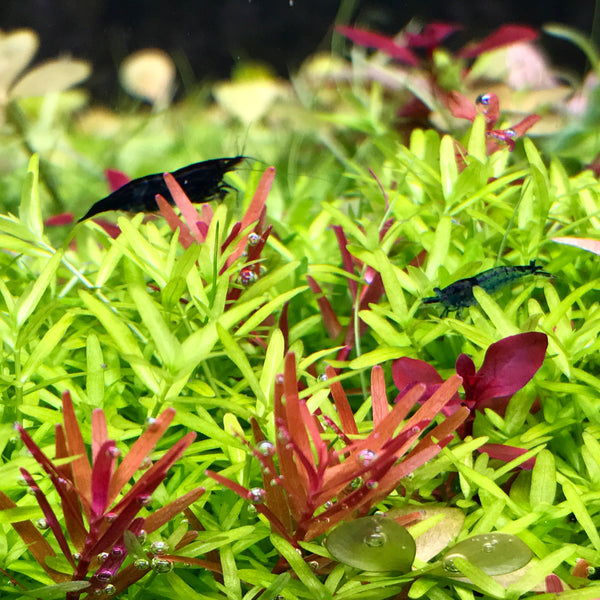A Beginner's Guide to Keeping Shrimp
Shrimp are Friends, Not Food!
As rewarding as fish can be to keep, sometimes more variety is needed. As you may have guessed by my Instagram handle (@shrimpery), I am a big fan of keeping freshwater shrimp as pets. In fact, they are what introduced me to the aquarium hobby! Here is a brief primer on how to go about keeping these friendly, colorful and prolific animals in your own tank.
First things first: the species of shrimp you select will determine how easy it is to keep and breed. I break down the selection into three categories-
In addition to being the species that I keep, Neocaridina is the easiest and cheapest to purchase of the three, and they will be the focus of this guide.
Neos, You are the Chosen One
Hardy, adaptable, and prolific, Neocaridina Davidi (aka the dwarf cherry shrimp) are an ideal choice for any aquarist interested in shrimp, especially beginners. There are many color variations, including, red, blue, black, and green; having been painstakingly bred to express these colors, it is inadvisable to keep multiple colors in the same tank. They will indiscriminately mate, and the offspring will often be a drab brown or clear color. My favorites are the “blue dream” and “black rose” varieties.
When purchasing shrimp, please keep in mind that they are social animals, and they do best in large groups of at least ten individuals. Any less than this and they will tend to hide, rather than graze as a group out in the open. I frequently see beginners make the mistake of buying just a couple shrimp for their community tank, then complaining that they never see the shrimp.
No New Friends
Large or aggressive fish are not suitable tankmates for shrimp. Barbs, bettas and many others will often bully or harass the shrimp, or else straight up eat the shrimp for dinner. Your best bet is a shrimp only aquarium, or else a tank with small, peaceful fish (such as ember tetras or corydoras), lots of vegetation, and a decent water volume.
Don't Mind the Crowds
Shrimp are very small and have a lower output of metabolic waste than fish, so they can be kept in smaller tanks/more densely populated conditions. With that said, I wouldn’t push it; it is best to do a maximum of 10-15 shrimp per five gallons. Really, a 20-gallon tank is best for breeding. If they are comfortable, Neocaridina shrimp will reproduce often (with a large enough baseline population, this will just happen with no special effort on the part of the owner), and you will soon find your tank filled with lots of tiny shrimplets. Almost any fish will gobble these baby shrimp up, so it makes sense to keep them in a shrimp only tank or a heavily planted tank if you want any of the shrimplets to survive and grow into adulthood. I have a large, breeding colony in my densely planted high tech, which contains a small fish population.
Neocaridina shrimp originate in temperate, shallow pools in Asia. This gives them the advantage of not really needing a heater (as long as your house stays in the 65-80 F range throughout the year). I find that mine are most comfortable and active around 70-76 F. They like relatively soft, acidic water, and in my experience will breed best in conditions around a pH of 6.8-7.5, GH 4-6, and a lower KH. Despite these preferences, they can usually adapt to most conditions, and can even live in somewhat hard water (although I wouldn’t advise it).
Shrimp are easier to keep than fish in many ways, but they are much more sensitive to changes in their water chemistry. Please note that they are very sensitive to copper and many other metals; excessive iron fertilization to achieve red plants or water supplements containing copper can result in swift death. The trace amount of iron found in a complete plant fertilizer is more than adequate for achieving the brightest red plants and should not harm your Neocaridina shrimp at low levels.
Where am I?
Shrimp react poorly to sudden changes in water conditions, much more so than fish. If you see your shrimp swimming all around the tank like fish after a water change, this means that they are not happy with the new water you have added. With that said, is important to do water changes at least once a week to avoid a buildup of waste (two 30 percent changes each week is better than one 50% change).
I do a lot of water changes in my high tech tank, but my shrimp do not mind since I take steps to ensure that the new water I am adding closely matches the parameters of the water already in the tank (you can read more about this in my previous article about understanding water parameters). Failure to adapt to new water conditions can result in jumping behavior or death. Shrimp do not typically jump or climb out of a tank if they are happy with the water parameters.
What about keeping shrimp in high tech tanks? Many people have success breeding Neocaridina shrimp in tanks with CO2 supplementation, but it’s important to make sure that the CO2 does not become excessive. This can be achieved by using a drop checker and making sure it is at a green color (as opposed to yellow). A fluctuating pH due to the CO2 levels changing is another thing to watch out for.
What do you want to eat? Whatevers...
As far as food goes, shrimp are scavengers with relatively low demands compared to fish. In a community tank, no specific feeding may be needed, as the shrimp will consume uneaten fish food, algae, and biofilm. In a dedicated shrimp tank or a tank with a sparse fish population, the shrimp can be fed a few times a week (with any uneaten food being removed after an hour or so). I feed mine SL-Aqua M.O.R.E White pellets.
I have been keeping and breeding Neocaridina shrimp in my high tech planted tanks for years with no issues, thanks to my adherence to the rules above. I hope that this guide will help you have success with yours. With the right housing and care, you will be able to breed your shrimp and will never have to buy any again!
______________
We hope this article on a beginner's guide to keeping freshwater shrimp species gives you the confidence and know-how to start your own colonies! For trusted products, check out our line of SL-Aqua products. Big thank you to Shrimpery for providing us with a thorough and beginner-friendly guide to freshwater shrimp keeping. Visit his Instagram for great planted tank photos, and knowledgeable posts!
Click below for more in-depth guides:
- A Guide for Keeping Freshwater Shrimp
- Guide: How to Breed Freshwater Shrimp
- Best Plants for a Freshwater Shrimp Tank
- Benefits of Live Plants for Breeding Fish/Shrimp
- Why Are My Shrimp Dying? (A Guide to Prevent Shrimp Deatrh)
- Planted Shrimp Tank: What is the Best Substrate?
Tell us - Was this article helpful? Please leave a comment below!
If you have any questions regarding this article, please DM us on Instagram, Facebook, or email support@buceplant.com so we can assist you - @buceplant









Comments
Leave a comment